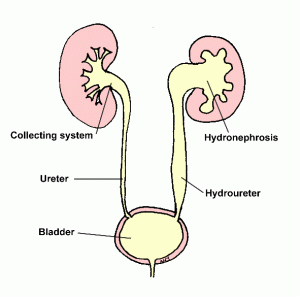If the tubes from the kidneys, or from the bladder, become blocked, this stops the kidneys from working. One kidney stopping working may not cause much trouble, if the other one is normal.
When does it cause kidney damage?
If the blockage is only for a short time, the kidneys can usually recover completely. However if the blockage is there for a long time (for many days or weeks), it can cause permanent kidney damage. This is called obstructive nephropathy, or obstructive uropathy.
What are the symptoms of obstruction?
There may be no symptoms from the obstruction at all, so that the only clues come from the kidneys not working properly. However one common cause, kidney stones, is usually very painful.
Things that block the way out from the bladder often cause trouble with passing urine, for example needing to pass urine much more often than usual. Complete obstruction of the bladder or of both kidneys causes you to stop passing urine completely.
 What causes obstruction?
What causes obstruction?
Many things can block urine flow. Here are some common causes:
| Stones | Kidney stones can block ureters. Usually these are painful. More info. |
| Prostate gland | In men, the prostate gland sits just underneath the bladder. It often gets bigger with age, and at first this slows urine flow. This is called benign prostatic hypertrophy, or BPH. Later BPH may block urine flow completely if it isn’t treated. More detailed info from Prodigy (UK) Prostate cancer may also block the urethra (tube out of the bladder). It most commonly occurs in elderly men, but usually responds well to treatment. BPH is a more common problem than cancer. |
| Bladder problems | If the nerves to the bladder are damaged, it may not empty properly. A tube (catheter) may be inserted to allow the urine to drain from the bladder. |
| Congenital | Some people are born with blockages. These can occur in different places. In boys, urethral valves may block the tube out of the bladder. |
| PUJ obstruction | PUJ = PelviUreteric Junction. This blockage right at the top of the ureter is probably often congenital. It can be repaired by an operation called pyeloplasty. |
| Cancer | Cancers growing in the bladder or ureters may cause obstruction. Many of these can be cured. Sometimes other cancers can spread into the ureters. More detailed info |
| Inflammation | In a disease called retroperitoneal fibrosis (RPF), the ureters can be narrowed by inflammation. Often steroids can treat the inflammation. |
How do you diagnose obstruction?
The collecting system of an obstructed kidney becomes blown up, and this can usually be seen on an ultrasound scan, or on CT or MRI scans. Sometimes these may also show the cause of the obstruction, but sometimes other tests are needed. More information about kidney tests.
What treatments are there for obstruction?
Removing the blockage is the best, but is not always easy, and usually a temporary method of relieving the obstruction is used first.
Obstruction to flow from the bladder can be relieved by inserting a catheter into the bladder. If this cannot be done through the urethra, sometimes it is necessary to put it directly into the bladder through the skin (suprapubic catheter)
For obstruction to the ureters, a temporary cure is to put a tube into the swollen collecting system of the kidney (see diagram above). This is usually done using ultrasound or X-rays to guide a needle into the right place. However carefully this is done, there is a risk of bleeding and damaging the kidney while doing this. The urine then drains through a tube that comes out of your back into a bag. This is called an antegrade nephrostomy. A plastic tube called a stent can sometimes be passed through the obstruction to relieve the block. Usually this is done later, when the kidney has recovered. It may be left in place for weeks or months. Sometimes a retrograde nephrostomy can be done via the bladder.
After obstruction is relieved
After the obstruction is removed or by-passed, the kidney may produce far too much urine for a time – this temporary rush is called post-obstructive diuresis. It may last several days. Fluids may need to be given into a vein to keep up.
After long-lasting obstruction, kidneys may not recover completely. Permanent kidney damage caused by obstruction is called obstructive nephropathy. Like other kinds of kidney damage, this can get worse even after the obstruction has been treated, though this usually happens very slowly. See chronic renal failure and its progression for more information about this.
Further information
On this website, the following page is particularly relevant:
- Chronic renal failure and its progression
Acknowledgements: The author of this page was Neil Turner. It was first published in June 2004. The date is was last modified is shown in the footer.

